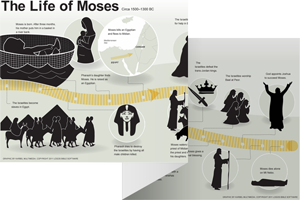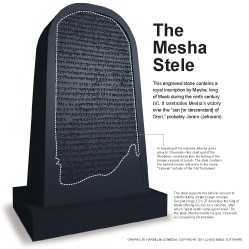21:1–3 Israel now comes into conflict with the Canaanites living in the Negev, namely the king of Arad. The archaeological site of Arad, which dates to this period, is important for understanding Canaanite religion as the backdrop of the ot. For example, an altar unearthed at Arad has four horns, similar to the ones described in the ot (e.g., Exod 27:1–8; 30:1–10; Ezek 43:15; compare 1 Kgs 1:50; 2:28). |
21:1 Canaanite The generic term for pre-Israelite inhabitants of the promised land.
inhabitants of the promised land.
took some of them captive Israel loses some of its members in the attack by the king of Arad. Kidnapping was treated as a capital offense, just as individual kidnapping was considered a capital offense for Israelites according to the law (Exod 21:16; Deut 24:7).
21:3 Hormah Meaning “destruction.” In Hebrew, “Hormah” is spelled with the same consonants (ch-r-m) as cherem (see Num 21:1).
21:4–9 The Israelites again complain about the lack of food and water, using language similar to their previous complaints (e.g., Exod 15:22–17:7; Num 11; 14; 20:1–13). This time, God punishes the people with venomous snakes. After Moses prays for the punishment to cease, God instructs him to make a bronze snake, promising to heal all those who look at it. John 3:14 draws an analogy between Moses lifting this bronze serpent and the metaphorical lifting up of the Son of Man. |
21:4 Mount Hor The place where Aaron died.
the Red Sea The Hebrew words used here, yam suph, may be translated “Red Sea” as opposed to the literal translation, “Sea of Reeds” (as in the exodus narrative; compare Exod 13:18; 15:4, 22).
to go around the land of Edom This move toward the Red Sea (or “Reed Sea,” yam suph in Hebrew) is a step backward from Arad (Num 21:1–3), and is due to the refusal of the king of Edom to let Israel pass through its land (20:14–21).
21:5 against God and against Moses The Israelites include God as the target of their complaint—one reason for the severity of the punishment.
our hearts detest this miserable food The people were not starving, they simply had contempt for the provisions God gave them—manna and quail.
21:6 poisonous snakes The Hebrew verb used here, saraph, means “burn,” but the noun is commonly used for a type of snake (e.g., Deut 8:15). The relationship between the terms likely derives from the burning pain of the venom from a snakebite, although it may also be the ancient Semitic name for a particular species of serpent. See note on Num 21:8.
poisonous snakes The Hebrew noun used here, nachash, is the common word for “snake.” The word sounds similar to nechosheth, the word for “bronze,” producing the wordplay found in v. 9, nechash nechosheth (“bronze serpent”).
21:8 Make for yourself a snake The Hebrew word used here, saraph, meaning “fiery,” likely refers to the shape after which Moses was to model the bronze serpent. Saraph occurs in Isa 14:29; 30:6, where the serpent is described as “flying.” The serpents referred to did not fly through the air; rather, the description comes from its appearance. The snake was likely a type of cobra whose upper body skin flanges were possibly thought to look like “wings.”
21:9 that person looked at the snake of bronze, he lived In the ancient Near East, serpents were widely associated with life and healing because they shed their skin. The prescientific observance of this ability led people to assume the serpent had regenerative power. Even today, the most common insignia associated with the medical profession contains two intertwined snakes.
21:10–20 This passage summarizes Israel’s route through the Transjordan. A more detailed description appears in Num 33:41–49. This section and the next (vv. 21–35) are not in chronological order, since the battle with the Amorites (vv. 21–35) would have likely been before Israel entered the Jordan Valley. As with many ot passages that list numerous locations, many of these sites are unknown. |
21:11 Moab A region due east of the Dead Sea.
21:12 the valley of Zered The Hebrew word used here, nachal, normally refers to a stream or wadi, which may be part of a valley formation. Wadi Zered has been identified with the Wadi el-Hesa which—at over 30 miles long—may have constituted the boundary between ancient Edom and Moab.
21:13 Arnon A stream flowing into the eastern side of the Dead Sea. Its deep canyon served as the natural northern boundary for the territory of Moab. The Arnon would later mark the southern border of the territory allotted to the tribe of Reuben (compare Deut 3:8, 16; Josh 13:16).
would later mark the southern border of the territory allotted to the tribe of Reuben (compare Deut 3:8, 16; Josh 13:16).
21:14 the scroll of the Wars of A lost book, or perhaps an epic poem. The work is not mentioned elsewhere in the ot. It was likely a poetic account of the war campaigns of Israel in Canaan. The book may have been part of a larger work with the book of Jashar (Jasher).
21:15 Ar May be the Hebrew term ir, meaning “a city” (changing only the vowel). Ar could alternatively be a city on the Arnon (Num 21:28; Deut 2:18).
21:16 to Beer Meaning “well”; this place-name is known from other passages (Judg 9:21; 2 Sam 4:2; Isa 15:8; Beer-elim, situated in Moab).
21:19 to Bamoth The Hebrew word bamoth means “high places” (compare Num 22:41). When used as a generic noun, “high places” refers to illicit shrines throughout Israel and Judah (e.g., Lev 26:30; 1 Kgs 3:2; 2 Kgs 17:9). The proper place name Bamoth (bamah) is attested the ot (Isa 15:2; 16:12; Jer 48:35) and in the Moabite Stela (line 3). As a place-name, Bamoth is used only of locations in Moab.
21:20 by the top of Pisgah Likely refers to a mountain range, though a mountain or a district that included mountains are also possible.
21:21–30 Moving north along the eastern edge of Moab, Israel requests passage through the Amorite kingdom of Sihon. As with Edom, the king refuses and meets Israel with an army (compare Num 20:20; 21:23). However, while Israel turned away and avoided armed conflict with Edom (20:21), they engage the Amorites and conquer their territory (vv. 24–26). Israel’s request for safe passage indicates they initially had no interest in possessing any territory in the Transjordan. This region was not part of the land originally promised to Abraham (Gen 12:1–3; 15:1–6, 18). Numbers 32 also indicates that, had the tribes of Reuben and Gad not asked to settle in these areas, they would have been left empty. |
 Giant Clans in the Old Testament
Giant Clans in the Old Testament
21:23 all his people This is a point of contrast with the king of Edom, who sent out only his army, albeit a large one (Num 20:20), and with fair warning (20:18).
21:24 Jabbok A river in the Transjordan often described as marking the border of Ammonite territory (Deut 3:16; Josh 12:2).
the Ammonites The Ammonite civilization and language is known from archaeological research. The Ammonites, like the Moabites, are descendants of Lot—Abraham’s nephew (see Gen 19:30–38).
21:29 Chemosh The patron deity of the Moabites (Jer 48:46). He is mentioned by name in the Moabite inscription called the Mesha Stele.
 Pagan Deities in the Old Testament Table
Pagan Deities in the Old Testament Table
21:30 Dibon A place name also mentioned in the Mesha Stele from Moab.
21:31 of the Amorites An ancient Semitic people associated with the Levant, especially northern Syria and northwestern Mesopotamia. In ot usage, the Amorites were one of the nations occupying Canaan prior to Israel’s arrival (Gen 15:19–21).
were one of the nations occupying Canaan prior to Israel’s arrival (Gen 15:19–21).
21:33 Og king of the Bashan According to Deut 3:11, Og was a descendant of giants. The ot and ancient Near Eastern Ugaritic literature
was a descendant of giants. The ot and ancient Near Eastern Ugaritic literature associate his territory, Bashan,
associate his territory, Bashan, with the Rephaim
with the Rephaim —referring either to a clan of giants or to the ghosts of dead kings dwelling there (Deut 1:4; 3:1–13).
—referring either to a clan of giants or to the ghosts of dead kings dwelling there (Deut 1:4; 3:1–13).
 Giant Clans in the Old Testament
Giant Clans in the Old Testament
at Edrei A city mentioned in association with the Rephaim on tablets found at the sites of the ancient cities Ugarit and Ashtaroth. The ot also couples these cities within the region of Bashan and associates them with the giant clan Rephaim (see Deut 1:4; Josh 12:4; 13:12).
and Ashtaroth. The ot also couples these cities within the region of Bashan and associates them with the giant clan Rephaim (see Deut 1:4; Josh 12:4; 13:12).

|
About Faithlife Study BibleFaithlife Study Bible (FSB) is your guide to the ancient world of the Old and New Testaments, with study notes and articles that draw from a wide range of academic research. FSB helps you learn how to think about interpretation methods and issues so that you can gain a deeper understanding of the text. |
| Copyright |
Copyright 2012 Logos Bible Software. |
| Support Info | fsb |
 Loading…
Loading…




